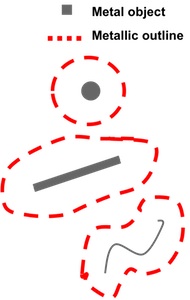background
Work in the area of cognitive engineering has suggested that expert
deminers mentally construct spatial patterns to make detection decisions. These patterns are
constructed by finding a point near a potential threat at which the metal detector responses
start and stop. By systematically finding several such points, experts build spatial patterns
(outline of the boundary points) of the metallic field belonging to the buried object or
collection of objects. If the encountered pattern is similar to one belonging to a landmine in
past experience, then the probability of a threat is high. By incorporating such procedures
into demining training programs, researchers have been able to improve performance of novice deminers.
problem
This technique, however, relies on operators' creation and retention of mental models that are subject to cognitive limitations such as working memory capacity. A rough analogy: how well can you remember a random pattern that someone traces out for you using their finger?
solution
Why rely on memory at all? To circumvent cognitive limitations associated with internal representation we present PETALS. PETALS allows the operator to build and see these patterns on a display screen. In effect, it helps novice deminers answer two questions: i) is there a mine present? and ii) where is the mine located?
